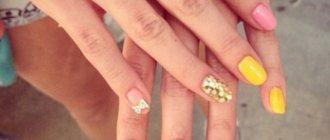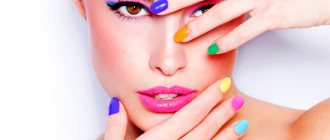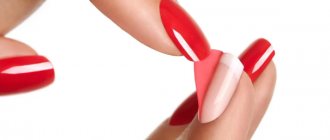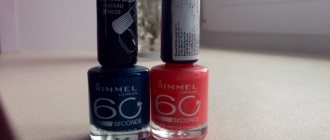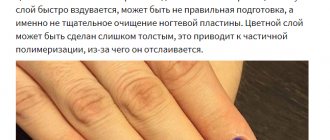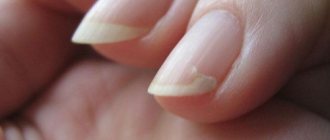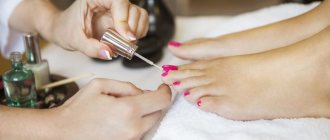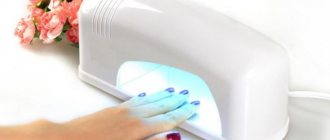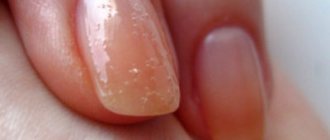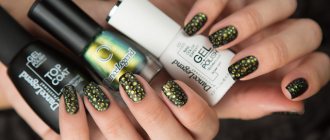Manicure with gel polish is not only covering the nail with a beautiful varnish or pattern, but also a technical process that requires skills and abilities. When working, manicurists face various problems. Including the fact that gel polish does not dry under a lamp.
Help: gel polishes are complex compositions, so drying them is a gradual transition of the composition from a liquid to a solid state. Therefore, it is more correct to say that gel polishes polymerize.
Manicure with gel polish always looks neat
Lamp dirty
Clean instruments are not only the calling card of the master and ensuring sterile conditions. A dirty lamp may cause the polymerization effect to weaken.
Therefore, it is necessary to wipe the lamp daily with the following liquids:
- Liquid for removing the sticky layer with medium dirt;
- Liquid for removing gel polish in case of increased contamination.
Liquid for removing sticky layer
Why doesn't gel polish dry in a lamp? Popular reasons
Many girls have a question: why doesn’t gel polish dry in a lamp? One of them had a sticky layer on top after drying. The second girl’s skin on her fingers was tanned, almost to the point of burning. The third client complains that the varnish is peeling off and curling up into pieces. The reason lies in the fact that before you start working with lamps, you need to study some nuances.
Not every lamp is suitable for every varnish. Before drying the varnish, you should read about it, find out which lamp should be used specifically for this type. All work with the coating should be carried out strictly according to the instructions. You may need a certain air temperature or a special liquid to remove the sticky layer.
Why gel polish does not dry in the lamp must be clarified from the very beginning. Ninety percent of failed experiments are due to incorrect purchase and unsuccessful use of special nail dryers. But you can learn how to select the necessary equipment and use them correctly. Let's look at the nuances and subtleties of this issue together, and learn how to choose the necessary drying agent for extended nails.
Content
Why do you need a lamp at all?
Simple varnishes dry perfectly on nails. Just sit quietly for 10 minutes and everything will be ready. Some masters advise placing nails painted with regular varnish under cold water to make drying faster. We tried it, it helps. Modeling varnishes and gel varnishes are created on special high-molecular polymers. These substances are not capable of evaporation, so they do not dry in the usual way. Even blowing a fan on your nails for an hour, or holding them over a warm radiator, will not produce a positive result. Shellac hardens only after its molecular structure changes. This is due to exposure to ultraviolet light.
Types of special devices. UV, LED, CCFL devices are used to harden special varnishes. All dryers operate on the same principle. The result of their illumination is a change in molecules. Polymers are included in decorative products from which artificial nails are formed. The pattern of polymer molecules changes and the artificial nails harden. The main difference between the types of devices is the way the radiation is generated.
UV devices
Dryers of this type have long been known, inexpensive, and are widely popular among craftsmen. These devices are characterized by high power and low cost. They produce extended spectrum ultraviolet light. Therefore, they are able to fix almost any varnishes and gels used to decorate nails. The main disadvantage of these dryers is their short service life. Ultraviolet light devices wear out over certain hours of operation. Also, any click of the switch brings the bulbs closer to burning out. If the device is turned on for a long time, the temperature of the luminous parts rises to 50°C. The metal casing of the device heats up. In this operating mode, you can burn the skin of your hands and fingers. The built-in fan only slightly reduces the temperature.
Therefore, it is not recommended to leave the dryer on for a long time while performing a manicure. The phosphor layer applied from the inside of the walls of the light bulbs becomes thinner, and ultraviolet radiation becomes weaker. Drying with such a defect does not produce a quality effect, and the polymerization of coatings takes too long. Sometimes the gel even pellets, cracks, and becomes a dirty yellowish color.
To avoid such troubles with partial polarization, the active elements in the ultraviolet device should be changed every two or three months, even before they completely burn out. There are devices on sale with induction and electronic switching filters. The induction ignition method protects the dryer from surges in the alternating voltage network and unauthorized power outages.
LED – drying
In LED lamps, ultraviolet rays are produced by special semiconductor parts - LEDs. Semiconductors operate stably, for a long time, without switching off for up to 100 thousand hours, they are environmentally friendly. LEDs do not deteriorate due to frequent switching on and off, their temperature does not increase due to prolonged operation, and the radiation strength does not decrease. Even when one or two LEDs fail, the overall drying efficiency does not decrease. Another positive feature of LED drying is the conversion of most of the energy into light rather than heat. Therefore, varnishes harden much faster and no ventilation is required for cooling. Without a fan, the device is smaller in size, price and weight than, for example, a UV device. A feature of LED dryers is that they produce short-wave light. Therefore, not all coatings harden equally quickly under their influence. Shellacs from recent years are set quickly, in a few seconds. But some take a very long time to harden, especially thick varnishes used to create artificial nails.
CCFL - devices
Cold glow fluorescent tubes decorate any shop windows and city advertisements. They have only recently been used to harden manicures. Inert gases sealed in glass drying tubes emit ultraviolet light. These dryers are much more durable than UV, they can last up to 80 thousand hours. The tubes do not heat up and do not wear out from frequent switching on. These dryers do not require constant replacement of parts. The light emitted by these devices has a wide spectrum of waves, which fixes gels of many modifications. Hybrid dryers with LEDs and fluorescent tubes are often used.
Range of light waves. Artificial nail dryers produce different ranges of light. Therefore, one gel may harden faster, while another may not dry at all. If you are not sure that short wave will set your gel, use a broad spectrum dryer.
Equipment power
LED and fluorescent devices have higher luminous energy. At the same time, they use less electricity. The energy consumed by UV drying to harden the coating on the entire hand is from 36 to 54 W, Inert tubes take 12-18 W, LEDs - from 9 to 12 W.
To use low-power devices, it is necessary to reduce the working area. For one finger, a 9 W UV lamp will handle the fixation. At a time when such a lamp for the fingers of the entire hand may turn out to be rather weak. The varnish will not harden. The speed and quality of fastening will be better from a device that produces light of the required range and greater intensity.
evagirl.ru
The lamp is not suitable for gel polish type
Most often, the type of drying lamp is indicated by a special marking on the varnish jar (UV for ultraviolet, LED for LED lamp). The latest generation of gel coatings produces varnishes that can polymerize in both types of lamps.
If the method of polymerization of the varnish is not indicated, then when purchasing a product you should ask the seller about this.
Important! In LED lamps, LEDs do not burn out and do not lose their power, therefore, if the selected coating does not require the use of a UV lamp, it is better to give preference to an LED lamp.
What you need to know about lamps
If you have a problem why gel polish does not dry under a lamp, then you most likely already know something about gel polishes and their polymerization. Next we will talk about the types of lamps and their features, and also talk about how each of them dries the gel.
UV lamps
They are the most inexpensive and popular; the polymerization of gel polish in them occurs as a result of exposure to luminescent glow. They have quite a lot of power, and the radiation can perfectly promote the hardening of helium compositions. At the same time, the service life of such lamps is very short, and not only the number of hours of operation is considered, but also the number of switches on and off.
With constant operation, they can heat up to 50 degrees, and also heat up the plastic or metal case and leave burns on the delicate skin of the fingers. Also, if you do not turn off the device throughout the entire manicure process, you will still not be able to reduce the wear resistance of the UV lamp.
If everything is so good with them, then why doesn’t the base or gel polish dry in a UV lamp? Let's explain. During long-term operation, the layer of phosphor that covers the inside of the light bulbs is destroyed and the ultraviolet radiation becomes less powerful, as a result the gel polish in the lamp does not harden at all, it is sticky, polymerizes unevenly, can roll or crack, and also acquire an ugly dirty yellow color. view. Therefore, if you want to dry your gel polish completely over the entire surface, then periodically, once every one or two months, change even the emitters that have not burned out.
LED lamps
LED lamps can work continuously for up to one hundred thousand hours, they are quite durable, and the gel polish in them hardens using ultraviolet radiation, which is created by LEDs. Unlike UV lamps, the number of turns off and on does not matter for them. LED radiation is not capable of heating the lamp body, and the rate of hardening of gel polish in LED lamps increases significantly compared to UV devices.
The only thing is that the ultraviolet radiation of LED lamps has a short range, so only gel polishes of the new generation or a certain type can harden in such drying. If there is a problem why gel polish does not dry in a lamp, then pay attention to whether it can harden under the influence of LEDs.
LED lamps are quite expensive compared to UV lamps. But this is only noticeable when you make a purchase. If you consider that having a UV dryer, you constantly spend money on replacing light bulbs, then over some time the price of both lamps will be equal.
CCFL lamps
Fluorescent lamps are familiar to us from the bright windows of shops, cafes and bars, and they have recently begun to be used for the polymerization of helium compounds. Their operating principle is similar to UV drying, but the current in the electrodes is generated not by an incandescent filament, but by gases contained in the tubes. The radiation they emit is many times more intense than that of UV devices, they are very durable, and also do not heat up the body of the device.
The lamp does not dry out the coating - this is not the case for them, since CCFL lamps emit a wide range of ultraviolet waves, so any, even the thickest, compositions harden very quickly and evenly in them.
About power
It seems like everything is fine with your lamp, but why doesn’t the gel polish dry in it? Perhaps it is the power of the UV waves. Do not forget that the last two types of lamps polymerize gel polishes much faster, using less power than UV lamps, so their optimal level for hardening on all fingers of the hand is 36 W, when for CCFL lamps it is 12-18 W, and for LED lamps - 9-12 W. Less powerful dryers are suitable for fixing gel or gel polish on one or two fingers at a time. If you have a situation where gel polish does not dry in a 36-watt lamp, then most likely the problem is in the varnish itself or the light bulbs need to be replaced.
Often on forums, experienced masters, as well as those who do manicures using gel polish at home, sharing their problems and experiences, discuss the problem of why black gel polish does not dry in a lamp. Remember, this color has a lot of pigment and to dry it well you need quite a lot of power. It will cure perfectly in all types of appliances, but if for some reason it does not do this, and you have a UV dryer, then you should change the bulbs in it.
About drying gel polish
Now let’s talk about how long it takes for gel polish to dry in a lamp. First of all, it depends on its radiation intensity and type. In less powerful dryers, the compositions harden more slowly, which means you can also dry your nails in them, but only longer and one finger at a time. If you dry your entire hand, the gel will not only not harden, but will wrinkle or remain sticky.
Please note that according to sanitary standards, gel polish can be dried in a lamp for no more than 10 minutes, each layer, when making multi-layer compositions, do not forget about this. To avoid harming the nail plate, use new generation products or the most powerful LED lamp.
Don’t be upset if you didn’t get the perfect manicure the first time and cover your nails with gel polish; if it doesn’t harden or becomes sticky, there is something to strive for. Use the information you described and next time you can avoid this type of problem. Good luck!
The varnish has expired
Do not neglect the expiration date indicated at the bottom of the bottle or on the label. As a rule, the shelf life of varnish is from 1 to 3 years from the moment the bottle is opened.
Important! Often the varnish can simply stagnate or become thick if it is not used for a long time, which also makes it take a long time to dry. In this case, you should first check whether its expiration date has expired, and then “reanimate” it by rolling it in your palms. It is not recommended to shake this varnish.
All gel polishes have a limited shelf life
Individual reasons, violation of care rules
Why does gel polish come off if you follow the application technique and use good material? There are such individual factors for premature violation of the integrity of the gel product on the nails:
- features of the nail plate (too thin, non-acceptance of foreign material);
- taking antibiotics;
- hormonal imbalance;
- often sweaty palms;
- marigold diseases;
- pregnancy;
- diabetes.
On lumpy, uneven nails, or if the plate is too thin, the coating will not last long. If the nails are yellowish in color, they are brittle and begin to split - this is a clear sign of illness. Therefore, first it is better to undergo a course of their treatment and strengthening. If you peel off the previous layers of gel with a nail file or other improvised materials, the plate will be damaged and the new coating will definitely not last long. Sometimes there are cases when, when applying a gel product for the first time, it is rejected, but this does not mean at all that the nails do not accept this type of manicure and the same thing will happen next time. Maybe they just need to adapt to the new material.
Pregnancy, diabetes, hormonal disorders, and hypertension can cause the nail to reject foreign material. In the first days of menstruation, it is also not recommended to use gel polish or false nails. This is due to hormonal changes in the body.
The gel product can quickly come off the nail as a result of improper care, so the following rules should be followed:
- It is not recommended to wet your hands during the first two hours after coating; on the first and second days after applying a manicure, you should not use chemicals
- means without gloves, visit baths and saunas; wet treatment of the nail with the use of oils, strengthening agents should be done no less
- than a day before gel coating;
- If it becomes necessary to cover the gel coating with regular varnish, the use of varnishes containing acetone is not recommended. Manicure removal should also be done with an acetone-free product.
Following these simple rules will help extend the life of your gel polish. And violations can lead to unpleasant consequences. It is recommended to warn the specialist about defects in the nail plate before work, this will allow him to choose the optimal means. There can be many answers to the question of why gel polish peels off. This is an individual problem.
Improper storage of varnish
This product is especially sensitive to light, so for proper storage of gel polish you must follow the following rules:
- Always close the bottle of varnish to avoid the harmful effects of both UV lamps and sunlight. Exposure to light may cause changes in the structure of the product. This is why most manufacturers produce varnishes in dark bottles;
- Do a manicure in artificial light to protect the polish from the harmful effects of daylight;
- Store varnishes in dark places;
- Avoid temperature changes. Store the varnish in a place that guarantees a constant temperature of 26 degrees. If the temperature regime is violated, the life of the varnish is significantly reduced.
In addition, gel polish does not like shaking. When shaken, air bubbles form in the bottle, which cause poor surface quality.
Each subsequent layer of manicure coating can be applied only after the previous one has been properly fixed. To do this, you need to know ways to check whether the nail polish is dry. How long it takes for nail polish to dry depends on many factors - its quality, layer thickness, application method, etc.
Today you can find a huge range of nail polishes on sale. They differ from each other not only in manufacturer and shade, but also in many other parameters. For example, composition, thickness, purpose, etc. Of course, they have varnishes and different prices. Each girl can choose among them the ideal product that suits her on all points at once.
It is difficult to definitively answer the question of how many minutes does it take for nail polish to dry. This also depends on many factors. Manicure varnish in general is enamel with the addition of a special colored pigment, which colors the nails. On average, its final hardening time is 20 minutes. During this time, the girl will receive the most uniform and hard layer of coating. As for quick-drying products, which are especially popular among customers today, their hardening time is 7-10 minutes.
Interestingly, the duration of drying will even depend on the ambient temperature, room humidity and preparation of the nail plate for coating.
To ensure that the polish looks especially attractive on your nails and that the contours of your fingers are not visible through them, and that the color of the product is bright and saturated, it is best to apply several layers of coating at once. The main thing is to thoroughly dry each previous one. You can make sure that the next layer is completely dry using various methods. The very first and most often used by girls is using a fingertip. To do this, you just need to tap it on the coating and make sure that the varnish stops sticking.
In beauty salons, the fair sex is most often asked to rub the nail plates of both hands against each other. If the coating feels perfectly smooth and nothing interferes with movement, it means the varnish is completely dry. You can start applying a fixing agent, which will make the manicure more durable.
Girls who are afraid of ruining the fresh coating with their actions taste the polish by lightly running their tongue over the nail. If the product tastes bitter, it means it has not dried enough. You need to wait a few more minutes and continue checking. Of course, this is not the best way. After all, nail polish has an unpleasant bitter taste and a composition unsafe for human health.
You can also check whether the coating is dry using a toothpick. In this case, you need to act as carefully as possible so as not to spoil your manicure. The thin end of a toothpick will need to be drawn along the side border of the coating. If the wooden accessory does not stain, then the varnish is completely dry.
There is another similar way to check - using white paper. Dried hardened varnish will not stain the material.
If a girl is in a hurry and wants to speed up the drying process of her nails, she can simply immerse them in ice water. In this case, the coating will become perfectly hard much faster. The same effect on the varnish is exerted by cold from the freezer, a stream of air from a hairdryer or fan. If you happen to have olive oil on hand, you should apply a small amount of it on top of the coating. This will significantly speed up the drying of the varnish.
There are several simple and accessible ways for everyone to check how well the nail polish has dried. The main thing, when using any of them, is to act as carefully and carefully as possible so as not to spoil the coating. Otherwise, you will have to reapply the varnish.
Incorrect nail treatment
Often masters violate the procedure for preparing the nail plate for manicure, which leads to the fact that the gel polish does not dry in the lamp.
The procedure for treating the nail is as follows:
- Treat your nails with a buff, which will create a rough surface for applying polish. Treating a nail with a polisher is a big mistake, since a too smooth surface of the nail plate prevents the uniform application of the varnish and, therefore, makes it difficult to polymerize;
- Apply cuticle oil after applying nail polish. Gel polish requires a dry and slightly rough surface. Cuticle oil makes the nail greasy, which creates an extra layer between the polish and the nail.
What happens if you overdry gel polish in a lamp?
In general, there is no such thing as “over-drying gel polish in a lamp”, because after the decorative coating hardens, all reactions stop, further influence of ultraviolet or LED waves does not have a negative impact on the final result. Even if the nails were in the lamp for 4 minutes instead of the required 2, then subsequently there will be no chips, cracks or a decrease in “use time”.
If the gel polish does not dry in the lamp, then you need to look for the reasons in the material itself, the lamp and the rules of the process technology. The process can be affected by low power of lighting equipment, low-quality or too light/highly pigmented varnish, severe contamination of the lamp, lack of a degreasing stage of the nail surface and other factors. When eliminating “provocateurs”, the process of drying gel polish in a lamp can be adjusted to perfection.
Wrong varnish
Today, the Internet is replete with offers from various brands of gel polishes in different price categories. In this variety, it is easy to make a mistake and buy a poor quality gel polish base that does not dry even if all the rules are strictly followed. Therefore, before choosing gel polish, you should carefully study customer reviews of the product, as well as the reputation of the manufacturer itself.
You should also not skimp on materials and tools for manicure. When choosing them, it is best to rely on the quality of the product. Good quality materials make the master’s work easier, and compliance with the above conditions not only improves polymerization, but also guarantees a longer manicure.
